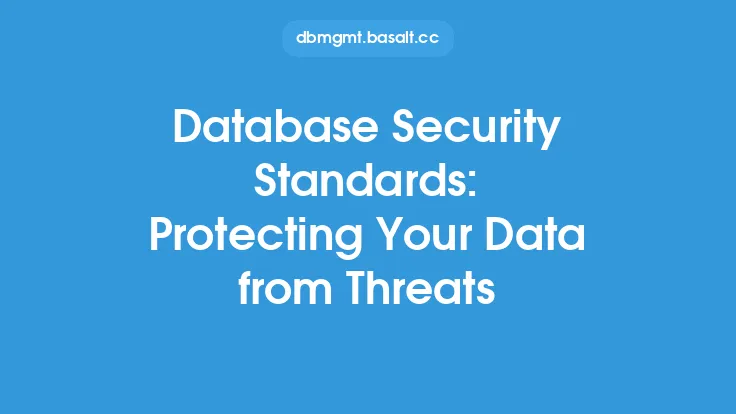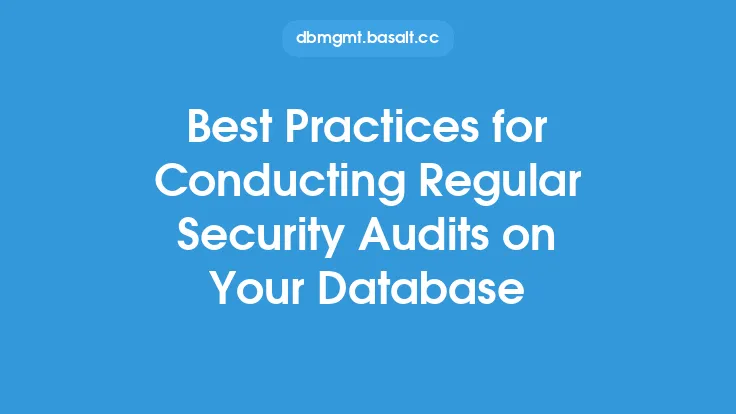Deploying a database is a critical step in making your data and applications available to users. However, it also exposes your data to potential security risks. Database deployment security is a crucial aspect of database implementation that involves protecting your data and applications from unauthorized access, use, disclosure, disruption, modification, or destruction. This article will delve into the importance of database deployment security, common security threats, and best practices for protecting your data and applications.
Introduction to Database Deployment Security
Database deployment security is a broad term that encompasses various measures to ensure the confidentiality, integrity, and availability of your data and applications. It involves implementing security controls, protocols, and procedures to prevent unauthorized access, use, or modification of your data. Database deployment security is not a one-time task, but rather an ongoing process that requires continuous monitoring, evaluation, and improvement. As your database grows and evolves, so do the security threats, making it essential to stay vigilant and adapt to new threats and vulnerabilities.
Common Security Threats
Database deployment security threats can be categorized into several types, including:
- Unauthorized access: Hackers or malicious insiders attempting to access your data without permission.
- Data breaches: Unauthorized disclosure of sensitive data, such as credit card numbers, personal identifiable information, or confidential business data.
- SQL injection attacks: Malicious code injected into your database to extract or modify sensitive data.
- Denial of Service (DoS) attacks: Overwhelming your database with traffic to make it unavailable to users.
- Malware and ransomware: Malicious software that can compromise your database, steal data, or demand ransom in exchange for restoring access.
- Insider threats: Authorized personnel intentionally or unintentionally compromising your database security.
Security Measures for Database Deployment
To protect your data and applications, implement the following security measures:
- Authentication and authorization: Implement strong authentication and authorization mechanisms, such as multi-factor authentication, to ensure only authorized personnel can access your database.
- Encryption: Encrypt sensitive data both in transit and at rest to prevent unauthorized access.
- Firewalls and network segmentation: Configure firewalls and network segmentation to restrict access to your database and limit the attack surface.
- Regular updates and patches: Regularly update and patch your database management system, operating system, and applications to fix vulnerabilities and prevent exploitation.
- Monitoring and logging: Continuously monitor and log database activity to detect and respond to security incidents.
- Backup and recovery: Implement a robust backup and recovery strategy to ensure business continuity in the event of a security incident or data loss.
Secure Database Configuration
A secure database configuration is essential to prevent security threats. Consider the following:
- Least privilege principle: Grant users and applications only the necessary privileges to perform their tasks, reducing the attack surface.
- Secure password management: Implement strong password policies, such as password rotation, complexity, and expiration.
- Disable unnecessary features: Disable unnecessary features and services to reduce the attack surface.
- Configure auditing and logging: Configure auditing and logging to monitor database activity and detect security incidents.
Network Security for Database Deployment
Network security plays a critical role in protecting your database from security threats. Consider the following:
- Virtual Private Networks (VPNs): Use VPNs to encrypt traffic between your database and applications.
- Transport Layer Security (TLS): Implement TLS to encrypt data in transit.
- Network segmentation: Segment your network to isolate your database and limit the attack surface.
- Intrusion Detection and Prevention Systems (IDPS): Implement IDPS to detect and prevent intrusion attempts.
Application Security for Database Deployment
Application security is critical to preventing security threats that can compromise your database. Consider the following:
- Input validation and sanitization: Validate and sanitize user input to prevent SQL injection attacks.
- Secure coding practices: Implement secure coding practices, such as secure coding guidelines and code reviews.
- Regular security testing: Regularly perform security testing, such as vulnerability scanning and penetration testing.
- Secure application configuration: Implement secure application configuration, such as secure password storage and secure authentication mechanisms.
Conclusion
Database deployment security is a critical aspect of database implementation that requires ongoing attention and effort. By understanding common security threats, implementing security measures, and configuring secure database and network settings, you can protect your data and applications from unauthorized access, use, disclosure, disruption, modification, or destruction. Remember, database deployment security is not a one-time task, but rather an ongoing process that requires continuous monitoring, evaluation, and improvement to stay ahead of emerging security threats and vulnerabilities.





